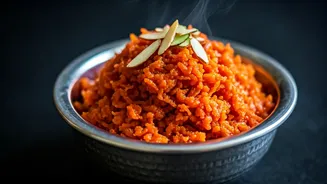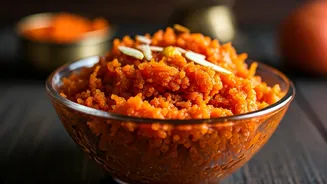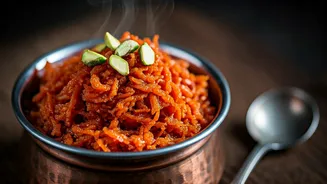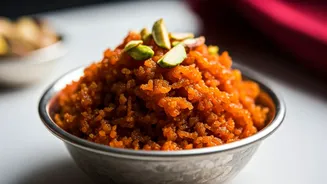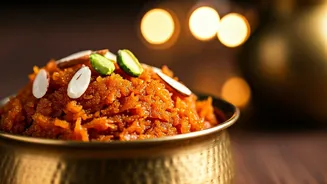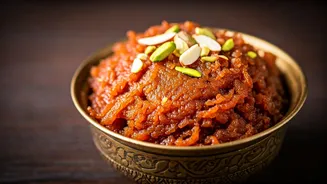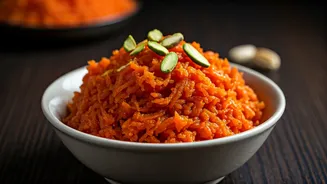Origins of Halwa
Gajar ka Halwa, a cherished dessert in Indian cuisine, has a fascinating history tied to Mughal influences. Legend has it that the dish's roots trace back
to the Mughal Empire, where elaborate desserts were a staple in royal kitchens. Carrots, a seasonal bounty, were transformed into this sweet delicacy through slow cooking with milk, sugar, and ghee. Over time, the recipe evolved, with different regions adding their unique touches, like the addition of nuts and spices, reflecting India's diverse culinary landscape. The dessert's popularity spread throughout the Indian subcontinent, becoming a symbol of celebration, especially during festive occasions. Its ability to bring people together, combined with its delectable taste, has cemented its place in the hearts and homes of people across India and beyond. The enduring appeal of Gajar ka Halwa is a testament to the enduring influence of Mughal culinary traditions, showcasing a blend of flavors that continues to captivate dessert lovers.
Essential Ingredients Needed
Creating the perfect Gajar ka Halwa requires a selection of fresh, high-quality ingredients that harmonize to create a symphony of flavors. Begin with approximately 1 kilogram of carrots, preferably the vibrant red variety, which, when grated, form the base of the dessert. Next, gather about 1 liter of full-fat milk, providing the creamy texture essential for this dish. Sugar, the sweetener of choice, should be measured according to taste, usually about 1 to 1.5 cups, though adjusting this depends on personal preferences. Clarified butter, or ghee, adds a rich, nutty flavor, with about a quarter of a cup needed for the cooking process. Include a selection of nuts like almonds, cashews, and pistachios, around 1/2 cup in total, coarsely chopped for texture and visual appeal. To enhance the aromatic profile, a pinch of cardamom powder is crucial. Optional additions include raisins, for a burst of sweetness, and a touch of saffron for color and an extra layer of flavor. Ensure you have these ingredients ready before starting the cooking process to ensure a smooth and satisfying culinary experience.
Preparing The Carrots
The journey to crafting a delightful Gajar ka Halwa begins with the preparation of the carrots, which is a key step in ensuring the final product's texture and flavor. First, thoroughly wash and peel about 1 kilogram of fresh carrots, discarding any imperfections. Next, grate the carrots using a grater's medium or fine side, as this helps achieve the right consistency. It's crucial to ensure that the carrots are grated uniformly to allow even cooking and a consistent texture throughout the dessert. If you prefer, you can use a food processor with a grating attachment, which can expedite this process. However, be mindful not to over-process the carrots, as this can affect the final texture. After grating, it's wise to set the grated carrots aside, allowing any excess moisture to drain slightly. This simple step contributes to a faster cooking time and prevents the halwa from becoming overly watery. The preparation of the carrots lays the foundation for a delightful dessert experience, so care in this stage is worthwhile.
The Cooking Process
The heart of Gajar ka Halwa lies in the cooking process, where the flavors meld and deepen. In a heavy-bottomed pan, ideally a non-stick one, heat the ghee over medium heat. Add the grated carrots and sauté them for around 10-15 minutes. This step helps to release the natural sweetness of the carrots and infuses the halwa with the rich aroma of the ghee. Then, pour in the full-fat milk, ensuring that it covers the carrots. Bring the mixture to a boil, then reduce the heat and simmer, stirring frequently to prevent sticking and burning. This slow cooking process, lasting approximately 45 minutes to an hour, allows the carrots to soften and the milk to reduce, creating a creamy texture. As the milk evaporates, the carrots will begin to absorb its sweetness. At this stage, add the sugar, adjusting the quantity based on your preference. Continue to cook, stirring continuously, until the milk has completely evaporated and the mixture begins to thicken. This is an important part of the cooking stage to achieve the right consistency. Towards the end, add cardamom powder and your preferred nuts. Continue cooking for a few more minutes, ensuring that the nuts are evenly distributed, before serving the warm and flavorful Gajar ka Halwa.
Serving and Variations
The enjoyment of Gajar ka Halwa extends to the presentation and the different ways it can be customized. Serve the halwa warm, ideally garnished with more chopped nuts and a swirl of ghee for added richness and visual appeal. This dessert is often enjoyed as a standalone treat or as part of a festive meal. For variations, experiment with different nuts, such as walnuts or macadamia nuts, to add new dimensions to the texture and flavor. Some recipes include adding a touch of khoya (dried milk solids) towards the end of cooking, enriching the halwa with a creamy, melt-in-your-mouth texture. A sprinkle of saffron strands, soaked in a bit of warm milk, can infuse the halwa with a luxurious color and aroma. For a twist, you can try adding a small amount of grated beetroot along with the carrots, adding a hint of color and extra nutrients. When it comes to serving, you could pair it with a scoop of vanilla ice cream, or a dollop of fresh cream to take your Gajar ka Halwa experience to another level.
